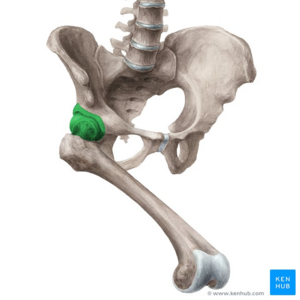Maximal Squat Test: Difference between revisions
(Created page with "{{subst: Special Test}}") |
No edit summary |
||
| Line 1: | Line 1: | ||
<div class="editorbox"> '''Original Editor '''- [[User: | <div class="editorbox"> '''Original Editor '''- [[User:Lilian Ashraf|Lilian Ashraf]]<br> | ||
'''Top Contributors''' - {{Special:Contributors/{{FULLPAGENAME}}}}</div> | '''Top Contributors''' - {{Special:Contributors/{{FULLPAGENAME}}}}</div> | ||
== Purpose< | == Purpose == | ||
[[File:Hip joint (anterolateral view) - Kenhub.png|thumb]] | |||
[[Femoroacetabular Impingement|Femoroacetabular impingement]] (FAI) is a cause of hip pain in young adults. It is caused by abnormal morphology in the head of the femur (CAM) or the acetabulm (PINCER). That leads to abnormal contact between the acetabular rim and the head of the femur resulting in repetitive microtrauma to the hip.<ref name=":0">Ayeni O, Chu R, Hetaimish B, Nur L, Simunovic N, Farrokhyar F, Bedi A, Bhandari M. A painful squat test provides limited diagnostic utility in CAM-type femoroacetabular impingement. Knee Surgery, Sports Traumatology, Arthroscopy. 2014 Apr;22(4):806-11.</ref> | |||
The maximal squat test is used for screening for FAI. Maximal or deep hip flexion during a squat, initiates the engagement of the CAM type femoral deformity into the acetabular socket.<ref name=":0" /> | |||
== Technique | == Technique == | ||
The patient stands with their legs shoulder apart and perform a deep squat reaching as low as possible. | |||
[[File:Squat Technique.jpeg|thumb]] | |||
The test is positive if the maximal squat recreated the patient’s typical hip and groin pain.<ref name=":0" /> | |||
== Evidence == | == Evidence == | ||
The sensitivity and specificity of the maximal squat test were 75 % and 41 %, respectively, for CAM-type FAI deformity. The positive and negative likelihood ratios were modest at 1.3 and 0.6, respectively.<ref name=":0" /> | |||
= | |||
== References == | == References == | ||
<references /> | <references /> | ||
[[Category:Special Tests]] | |||
[[Category:Hip - Assessment and Examination]] | |||
[[Category:Hip]] | |||
Revision as of 03:00, 7 November 2022
Purpose[edit | edit source]
Femoroacetabular impingement (FAI) is a cause of hip pain in young adults. It is caused by abnormal morphology in the head of the femur (CAM) or the acetabulm (PINCER). That leads to abnormal contact between the acetabular rim and the head of the femur resulting in repetitive microtrauma to the hip.[1]
The maximal squat test is used for screening for FAI. Maximal or deep hip flexion during a squat, initiates the engagement of the CAM type femoral deformity into the acetabular socket.[1]
Technique[edit | edit source]
The patient stands with their legs shoulder apart and perform a deep squat reaching as low as possible.
The test is positive if the maximal squat recreated the patient’s typical hip and groin pain.[1]
Evidence[edit | edit source]
The sensitivity and specificity of the maximal squat test were 75 % and 41 %, respectively, for CAM-type FAI deformity. The positive and negative likelihood ratios were modest at 1.3 and 0.6, respectively.[1]








